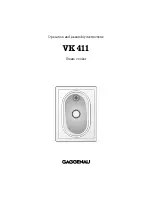
16
17
8. What does it mean when E3 appears in the display window and the unit stops
working?
The cooker has overheated. You likely operated the unit in pressure cooking mode
with insufficient or no liquid. If this occurs, unplug the unit and allow it to cool. Then
remove the cover and add liquid to the cooker. Plug the unit back in, place the cover
on, and reprogram the cooker.
9. Sometimes my food is not completely done after the recommended cooking time.
When I try to put the cover back on the cooker, so I can cook it longer, the cover
will not close. How can I get the cover closed?
Allow the pressure cooker to cool slightly. When the cooker is still hot, the air vent/
cover lock will lift, preventing you from closing the cover. Before placing the cover
back on, be sure the quick pressure release valve is in the
STEAM OUT
position.
Once the cover is closed, move the lever to the
COOK
position.
10. What can be done if the food prepared in the pressure cooker has more liquid
than desired?
With the cover removed, press
SAUTÉ
and allow the excess liquid to evaporate. Next
time you prepare the same recipe, you may want to use less liquid.
11. I believe I am thoroughly cleaning my cooker, but sometimes I notice the odor of
my last meal remains in the cooker. Is there something I am doing wrong?
The sealing ring is made of silicone. Silicone has many wonderful properties but it
does tend to retain odors. Over time, the odor will dissipate.
12. What does it mean when E1, E2, E4, or E5 appear in the display window and the
unit stops working?
This means something internally has become damaged, been tampered with, or is
defective. The unit will be inoperable if you get one of these codes. You should
unplug the unit and contact our Customer Service Department. Call weekdays
8:00 AM to 4:00 PM (Central Time) at 1-800-877-0441 or email us through our
website at www.GoPresto.com/contact.
PRESSURE COOKING RECIPES
Soups and Stews
This pressure cooker is perfect for preparing delicious soups and stews. Included are a
few favorite recipes. If you have a favorite recipe of your own, try it using one of the
recipes in this book as your guide. If adding dry beans and peas, they first must be soaked
according to the directions on page 30.
CAUTION!
Do not pressure cook soups containing barley, rice, pasta, grains, split peas,
and dried soup mixes because they have a tendency to foam, froth, and sputter and could
block the vent pipe. These foods should be added to the soup AFTER pressure cooking.
FOR SOUPS AND STEWS, DO NOT FILL COOKING POT OVER ½ FULL!
1½ pounds bone-in chicken breasts,
skinned
1 cup celery, cut into 2-inch pieces
1 cup coarsely chopped onion
3 cloves garlic, halved
1 teaspoon dried thyme
¾ teaspoon salt
½ teaspoon black pepper
4 cups water
• • • • • • •
1½ cups sliced carrots
1 cup sliced celery
2 green onions, thinly sliced
Add chicken, celery, onion, garlic, thyme, salt,
pepper, and water to cooking pot. Close cover.
Place quick pressure release valve on vent pipe.
Press
SOUP
and then adjust time to 10 minutes.
When time is up, allow pressure to drop of its
own accord.
Remove chicken to a cutting board and allow
to cool. Strain stock by pouring through a large
sieve; discard solids. Return stock to cooking
pot; add carrots and celery. Press
CANCEL
.
Close cover. Place quick pressure release valve
on vent pipe. Press
VEGETABLES–HIGH
and
then adjust time to 3 minutes.
Meanwhile, remove chicken from bones and cut
into bite-size pieces.
When cooking time is up, quickly release
pressure.
Return chicken to cooking pot and add onions;
allow to heat through.
7 servings
Classic Chicken Soup






































